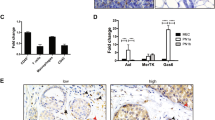Abstract
Introduction
We hypothesized that breast tissue not involved by tumor in inflammatory breast cancer (IBC) patients contains intrinsic differences, including increased mammary stem cells and macrophage infiltration, which may promote the IBC phenotype.
Materials and methods
Normal breast parenchyma ≥ 5 cm away from primary tumors was obtained from mastectomy specimens. This included an initial cohort of 8 IBC patients and 60 non-IBC patients followed by a validation cohort of 19 IBC patients and 25 non-IBC patients. Samples were immunostained for either CD44+CD49f+CD133/2+ mammary stem cell markers or the CD68 macrophage marker and correlated with IBC status. Quantitation of positive cells was determined using inForm software from PerkinElmer. We also examined the association between IBC status and previously published tumorigenic stem cell and IBC tumor signatures in the validation cohort samples.
Results
8 of 8 IBC samples expressed isolated CD44+CD49f+CD133/2+ stem cell marked cells in the initial cohort as opposed to 0/60 non-IBC samples (p = 0.001). Similarly, the median number of CD44+CD49f+CD133/2+ cells was significantly higher in the IBC validation cohort as opposed to the non-IBC validation cohort (25.7 vs. 14.2, p = 0.007). 7 of 8 IBC samples expressed CD68 + histologically confirmed macrophages in initial cohort as opposed to 12/48 non-IBC samples (p = 0.001). In the validation cohort, the median number of CD68 + cells in IBC was 3.7 versus 1.0 in the non-IBC cohort (p = 0.06). IBC normal tissue was positively associated with a tumorigenic stem cell signature (p = 0.02) and with a 79-gene IBC signature (p < 0.001).
Conclusions
Normal tissue from IBC patients is enriched for both mammary stem cells and macrophages and has higher association with both a tumorigenic stem cell signature and IBC-specific tumor signature. Collectively, these data suggest that IBC normal tissue differs from non-IBC tissue. Whether these changes occur before the tumor develops or is induced by tumor warrants further investigation.





Similar content being viewed by others
References
Iwamoto T et al (2011) Different gene expressions are associated with the different molecular subtypes of inflammatory breast cancer. Breast Cancer Res Treat 125(3):785–795
Van Laere SJ et al (2013) Uncovering the molecular secrets of inflammatory breast cancer biology: an integrated analysis of three distinct affymetrix gene expression datasets. Clin Cancer Res 19(17):4685–4696
Woodward WA et al (2013) Genomic and expression analysis of microdissected inflammatory breast cancer. Breast Cancer Res Treat 138(3):761–772
Woodward WA (2015) Inflammatory breast cancer: unique biological and therapeutic considerations. Lancet Oncol 16(15):e568–576
Atkinson RL et al (2016) Epidemiological risk factors associated with inflammatory breast cancer subtypes. Cancer Causes Control, 27(3):359–366
Robertson FM et al (2010) Inflammatory breast cancer: the disease, the biology, the treatment. CA Cancer J Clin 60(6):351–375
Morris PG et al (2011) Inflammation and increased aromatase expression occur in the breast tissue of obese women with breast cancer. Cancer Prev Res (Phila) 4(7):1021–1029
O’Brien J et al (2010) Alternatively activated macrophages and collagen remodeling characterize the postpartum involuting mammary gland across species. Am J Pathol 176(3):1241–1255
Stein T et al (2009) A mouse mammary gland involution mRNA signature identifies biological pathways potentially associated with breast cancer metastasis. J Mammary Gland Biol Neoplasia 14(2):99–116
Sun X et al (2012) Normal breast tissue of obese women is enriched for macrophage markers and macrophage-associated gene expression. Breast Cancer Res Treat 131(3):1003–1012
Asselin-Labat ML et al (2010) Control of mammary stem cell function by steroid hormone signalling. Nature 465(7299):798–802
Shinde SS et al (2010) Higher parity and shorter breastfeeding duration: association with triple-negative phenotype of breast cancer. Cancer 116(21):4933–4943
Meyer MJ et al (2010) CD44posCD49fhiCD133/2hi defines xenograft-initiating cells in estrogen receptor-negative breast cancer. Cancer Res 70(11):4624–4633
Atkinson RL et al (2013) Cancer stem cell markers are enriched in normal tissue adjacent to triple negative breast cancer and inversely correlated with DNA repair deficiency. Breast Cancer Res 15(5):R77
Li C, Wong WH (2001) Model-based analysis of oligonucleotide arrays: expression index computation and outlier detection. Proc Natl Acad Sci U S A 98(1):31–3 6
Creighton CJ et al (2009) Residual breast cancers after conventional therapy display mesenchymal as well as tumor-initiating features. Proc Natl Acad Sci USA 106(33):13820–13825
Chang S, Buzdar AU, Hursting SD (1998) Inflammatory breast cancer and body mass index. J Clin Oncol 16(12):3731–3735
Schairer C et al (2013) Risk factors for inflammatory breast cancer and other invasive breast cancers. J Natl Cancer Inst 105(18):1373–1384
Weisberg SP et al (2003) Obesity is associated with macrophage accumulation in adipose tissue. J Clin Invest 112(12):1796–1808
Lacerda L et al (2015) Mesenchymal stem cells mediate the clinical phenotype of inflammatory breast cancer in a preclinical model. Breast Cancer Res 17:42
Polyak K (2006) Pregnancy and breast cancer: the other side of the coin. Cancer Cell 9(3):151–153
Schedin P (2006) Pregnancy-associated breast cancer and metastasis. Nat Rev Cancer 6(4):281 – 91
Huh SJ et al (2015) Age- and pregnancy-associated DNA methylation changes in mammary epithelial cells. Stem Cell Rep 4(2):297–311
Wolfe AR et al (2016) Mesenchymal stem cells and macrophages interact through IL-6 to promote inflammatory breast cancer in pre-clinical models. Oncotarget 7(50):82482–82492
Ruffell B et al (2012) Leukocyte composition of human breast cancer. Proc Natl Acad Sci U S A 109(8):2796–2801
Acknowledgements
Funding was provided by National Institutes of Health (Grant Nos. R01CA138239-01, 1R01CA180061-01)
Author information
Authors and Affiliations
Corresponding author
Ethics declarations
Conflict of interest
The authors have no conflict of interest to declare.
Electronic supplementary material
Below is the link to the electronic supplementary material.
Rights and permissions
About this article
Cite this article
Reddy, J.P., Atkinson, R.L., Larson, R. et al. Mammary stem cell and macrophage markers are enriched in normal tissue adjacent to inflammatory breast cancer. Breast Cancer Res Treat 171, 283–293 (2018). https://doi.org/10.1007/s10549-018-4835-6
Received:
Accepted:
Published:
Issue Date:
DOI: https://doi.org/10.1007/s10549-018-4835-6




